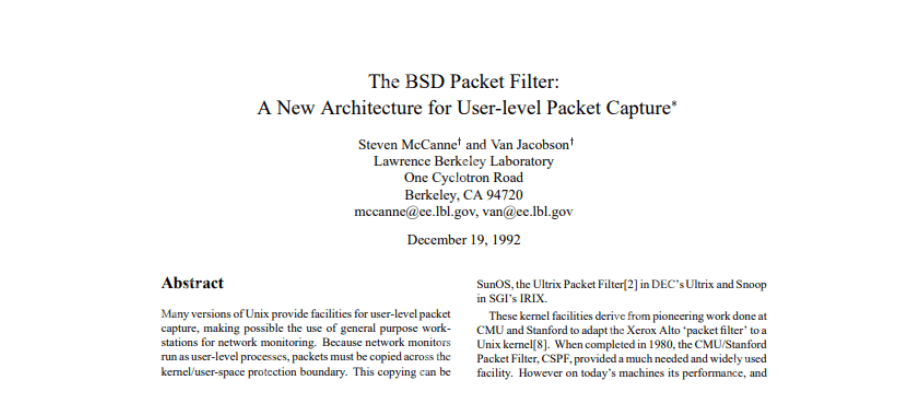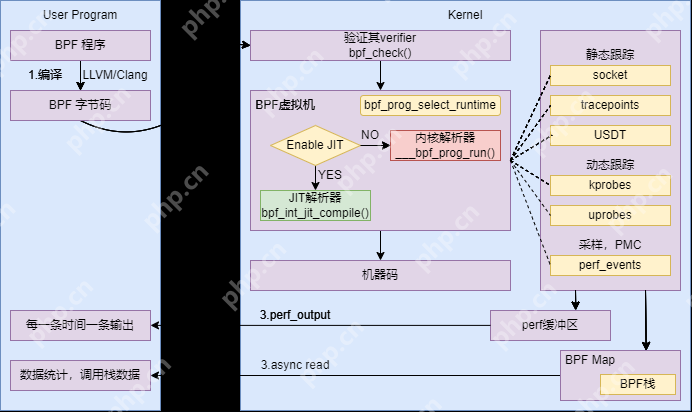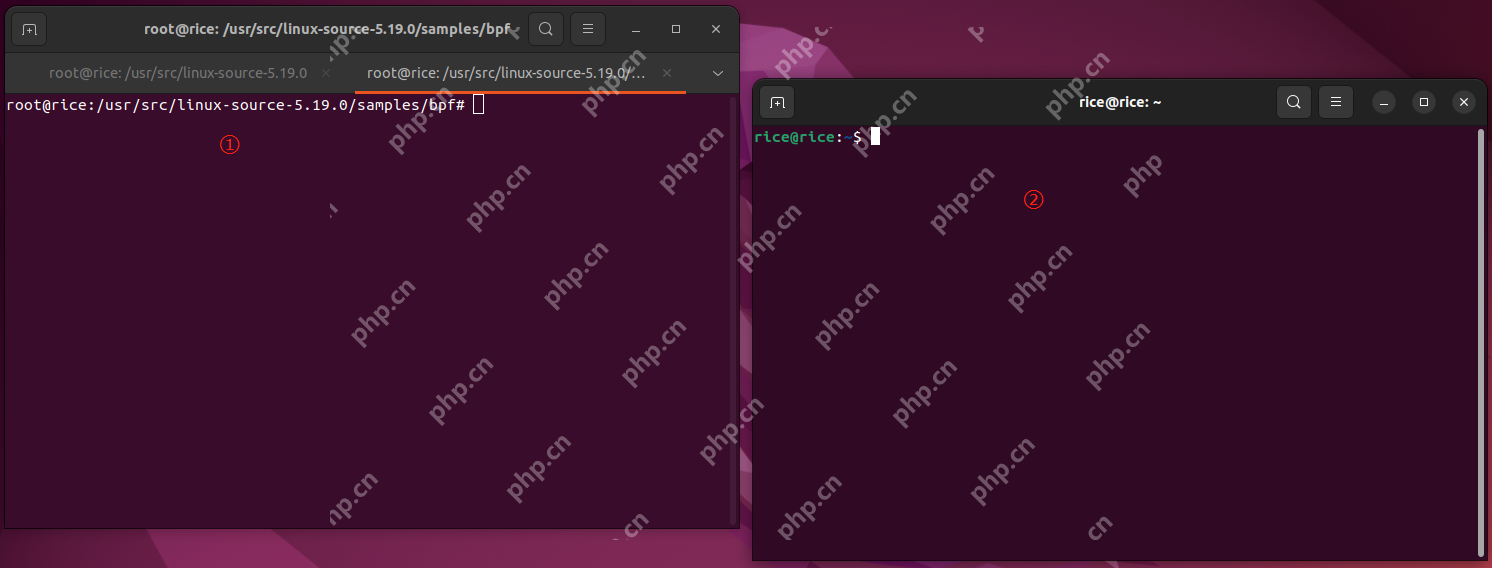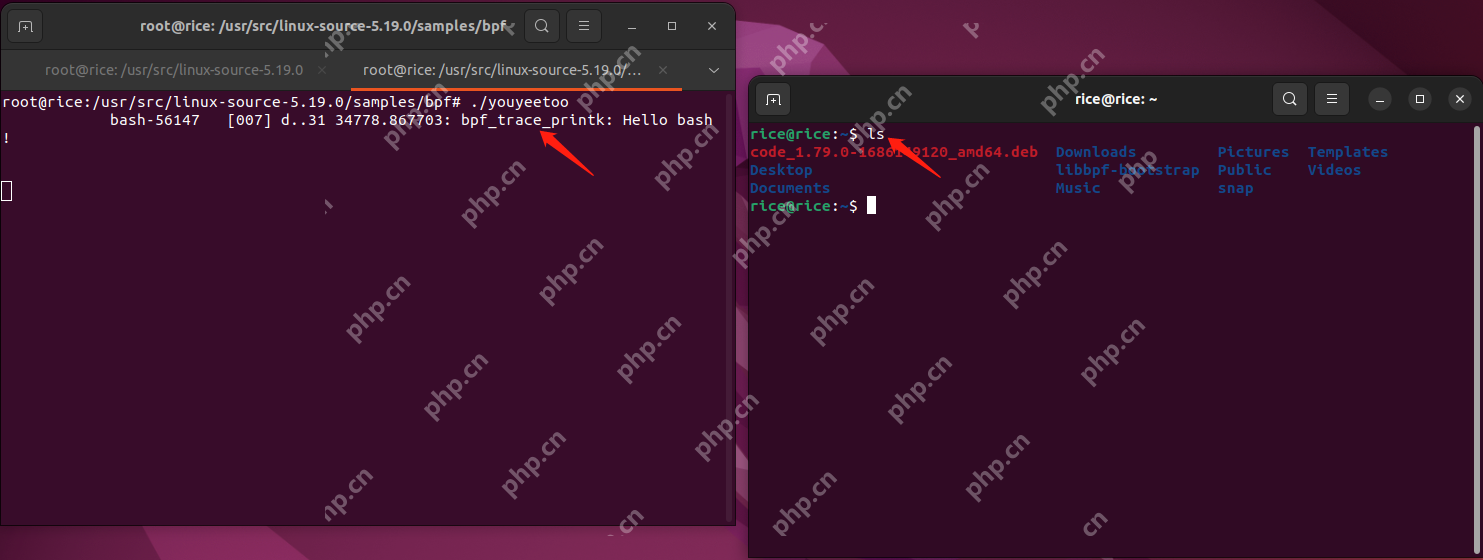我早前接觸ebpf技術(shù)時,對其用途和解決的問題一頭霧水,因此未能深入研究。幸運的是,近期我有機會深入探討這一技術(shù)。
什么是BPF?BPF,即Berkley Packet Filter(伯克利報文過濾器),其設(shè)計靈感來源于1992年Steven McCanne和Van Jacobson撰寫的論文《The BSD packet Filter: A New architecture for user-level packet capture》(《BSD數(shù)據(jù)包過濾器:一種用于用戶級數(shù)據(jù)包捕獲的新體系結(jié)構(gòu)》)。最初,BPF是在BSD內(nèi)核中實現(xiàn)的,后因其卓越的設(shè)計理念,被其他操作系統(tǒng)如Linux所采用。
 該論文中,作者描述了他們在unix內(nèi)核中實現(xiàn)網(wǎng)絡(luò)數(shù)據(jù)包過濾的方法,這種新技術(shù)比當(dāng)時最先進(jìn)的數(shù)據(jù)包過濾技術(shù)快20倍。下圖來自論文:
該論文中,作者描述了他們在unix內(nèi)核中實現(xiàn)網(wǎng)絡(luò)數(shù)據(jù)包過濾的方法,這種新技術(shù)比當(dāng)時最先進(jìn)的數(shù)據(jù)包過濾技術(shù)快20倍。下圖來自論文:
 簡而言之,BPF作為網(wǎng)絡(luò)報文傳輸?shù)呐月锋溌罚?dāng)接收到的網(wǎng)絡(luò)報文到達(dá)內(nèi)核驅(qū)動程序后,報文在傳輸給網(wǎng)絡(luò)協(xié)議棧的同時,會將其副本傳輸給BPF。之后,報文會通過BPF程序的內(nèi)部邏輯進(jìn)行過濾,最終再送到用戶程序。
簡而言之,BPF作為網(wǎng)絡(luò)報文傳輸?shù)呐月锋溌罚?dāng)接收到的網(wǎng)絡(luò)報文到達(dá)內(nèi)核驅(qū)動程序后,報文在傳輸給網(wǎng)絡(luò)協(xié)議棧的同時,會將其副本傳輸給BPF。之后,報文會通過BPF程序的內(nèi)部邏輯進(jìn)行過濾,最終再送到用戶程序。
BPF在數(shù)據(jù)包過濾上引入了兩大創(chuàng)新:
- 一個新的虛擬機(VM)設(shè)計,能夠有效地在基于寄存器結(jié)構(gòu)的CPU上運行;
- 應(yīng)用程序使用緩存只復(fù)制與過濾數(shù)據(jù)包相關(guān)的數(shù)據(jù),不會復(fù)制數(shù)據(jù)包的所有信息,最大程度地減少BPF處理的數(shù)據(jù),提高處理效率。我們熟悉的tcpdump就是基于BPF技術(shù),堪稱一個神器。
什么是eBPF?BPF發(fā)展至今,已升級為eBPF,即「extended Berkeley Packet Filter」。它演變成了一套通用執(zhí)行引擎,提供基于系統(tǒng)或程序事件高效安全執(zhí)行特定代碼的能力,不再局限于內(nèi)核開發(fā)者。其應(yīng)用場景擴展到網(wǎng)絡(luò)分析、性能分析、系統(tǒng)追蹤、網(wǎng)絡(luò)優(yōu)化等多種類型的工具和平臺。
 eBPF技術(shù)架構(gòu)圖:
eBPF技術(shù)架構(gòu)圖:
 eBPF主要分為用戶空間程序與內(nèi)核程序兩部分:
eBPF主要分為用戶空間程序與內(nèi)核程序兩部分:
在用戶空間,程序通過LLVM/Clang編譯成eBPF可接受的字節(jié)碼并提交到內(nèi)核,并負(fù)責(zé)讀取內(nèi)核回傳的消息事件或統(tǒng)計信息。eBPF提供了兩種內(nèi)核態(tài)與用戶態(tài)傳遞數(shù)據(jù)的方式,即內(nèi)核態(tài)可以將自定義perf_event消息事件發(fā)往用戶態(tài),或用戶態(tài)通過文件描述符讀寫存儲在內(nèi)核中的k/v map數(shù)據(jù)。在內(nèi)核空間,為了確保穩(wěn)定與安全,eBPF接收的字節(jié)碼首先會交給Verifier進(jìn)行安全驗證,如驗證程序循環(huán)次數(shù)、數(shù)組越界問題、無法訪問的指令等。只有通過校驗的字節(jié)碼才會提交到內(nèi)核自帶編譯器或JIT編譯器編譯成可直接執(zhí)行的機器指令。同時,eBPF對提交程序提出限制,如程序大小限制、最大可使用堆棧大小限制、可調(diào)用函數(shù)限制、循環(huán)次數(shù)限制等。從架構(gòu)圖中可以看出,eBPF在內(nèi)核態(tài)依賴內(nèi)核探針工作,其中kprobes實現(xiàn)內(nèi)核函數(shù)動態(tài)跟蹤;uprobes實現(xiàn)用戶函數(shù)動態(tài)跟蹤;tracepoints是內(nèi)核中的靜態(tài)跟蹤點;perf_events支持定時采樣和PMC。
eBPF環(huán)境搭建為了驗證eBPF程序編寫,我在Ubuntu22.04中搭建了eBPF環(huán)境,ubuntu22.04的安裝流程在此不贅述。以下操作均在root用戶下執(zhí)行。
更新系統(tǒng)的包索引和包列表:
# apt update
編譯BPF程序需要系統(tǒng)安裝必備的linux-headers包:
# sudo apt install Linux-headers-$(uname -r)
安裝eBPF依賴工具:
# apt install -y bison flex build-essential git cmake make libelf-dev strace tar libfl-dev libssl-dev libedit-dev zlib1g-dev Python python3-distutils
安裝LLVM,并檢查版本:
# apt install llvm # llc -version Ubuntu LLVM version 14.0.0 ..... wasm32 - WebAssembly 32-bit wasm64 - WebAssembly 64-bit x86 - 32-bit X86: Pentium-Pro and above x86-64 - 64-bit X86: EM64T and AMD64 xcore - XCore #
安裝Clang,并檢查版本:
# apt install clang # clang -version Ubuntu clang version 14.0.0-1ubuntu1 Target: x86_64-pc-linux-gnu Thread model: posix InstalledDir: /usr/bin #
查看當(dāng)前ubuntu的內(nèi)核版本,安裝對應(yīng)的內(nèi)核源碼,并解壓源碼:
# apt-cache search linux-source linux-source - Linux kernel source with Ubuntu patches linux-source-5.19.0 - Linux kernel source for version 5.19.0 with Ubuntu patches # apt install linux-source-5.19.0 # cd /usr/src # tar -jxvf linux-source-5.19.0.tar.bz2 # cd linux-source-5.19.0
編譯內(nèi)核源碼的bpf模塊,如果沒有報錯,說明已經(jīng)完成環(huán)境搭建:
# cp -v /boot/config-$(uname -r) .config # make oldconfig && make prepare # make headers_install # apt-get install libcap-dev # make M=samples/bpf CC samples/bpf/../../tools/testing/selftests/bpf/cgroup_helpers.o CC samples/bpf/../../tools/testing/selftests/bpf/trace_helpers.o CC samples/bpf/cookie_uid_helper_example.o CC samples/bpf/cpustat_user.o CC samples/bpf/fds_example.o ... WARNING: Symbol version dump "Module.symvers" is missing. Modules may not have dependencies or modversions. You may get many unresolved symbol warnings.
eBPF樣例編寫內(nèi)核源碼的samples/bpf目錄下提供了許多實例供學(xué)習(xí),通過目錄下的makefile可以構(gòu)建其中的bpf程序。如果我們用c語言編寫B(tài)PF程序,可以直接在該目錄提供的環(huán)境中進(jìn)行編譯。
samples/bpf下的程序通常由xxx_user.c和xxx_kern.c組成:
xxx_user.c:為用戶空間程序,用于設(shè)置BPF程序的相關(guān)配置、加載BPF程序至內(nèi)核、設(shè)置BPF程序中的map值和讀取BPF程序運行過程中發(fā)送至用戶空間的消息等。目前xxx_user.c與xxx_kern.c程序在交互實現(xiàn)上都是基于bpf()系統(tǒng)調(diào)用完成的。直接使用bpf()系統(tǒng)調(diào)用涉及的參數(shù)和細(xì)節(jié)較多,使用門檻較高,因此為了方便用戶空間程序更加易用,內(nèi)核提供了libbpf庫封裝了對于bpf()系統(tǒng)調(diào)用的細(xì)節(jié)。 xxx_kern.c:為BPF程序代碼,通過clang編譯成字節(jié)碼加載至內(nèi)核中,在對應(yīng)事件觸發(fā)時運行,可以接受用戶空間程序發(fā)送的各種數(shù)據(jù),并將運行時產(chǎn)生的數(shù)據(jù)發(fā)送至用戶空間程序。
編寫一個樣例流程,在目錄samples/bpf中新建兩個文件:youyeetoo_user.c和youyeetoo_kern.c,并在makefile中加入構(gòu)建:
youyeetoo_user.c的內(nèi)容:
#include <stdio.h> #include <unistd.h> #include <bpf> #include "trace_helpers.h" <p>int main(int ac, char *<em>argv) { struct bpf_link </em>link = NULL; struct bpf_program <em>prog; struct bpf_object </em>obj; char filename[256];</p><pre class="brush:php;toolbar:false">snprintf(filename, sizeof(filename), "%s_kern.o", argv[0]); obj = bpf_object__open_file(filename, NULL); if (libbpf_get_error(obj)) { fprintf(stderr, "ERROR: opening BPF object file failedn"); return 0; } prog = bpf_object__find_program_by_name(obj, "bpf_prog"); if (!prog) { fprintf(stderr, "ERROR: finding a prog in obj file failedn"); goto cleanup; } /* load BPF program */ if (bpf_object__load(obj)) { fprintf(stderr, "ERROR: loading BPF object file failedn"); goto cleanup; } link = bpf_program__attach(prog); if (libbpf_get_error(link)) { fprintf(stderr, "ERROR: bpf_program__attach failedn"); link = NULL; goto cleanup; } read_trace_pipe();
cleanup: bpf_link__destroy(link); bpf_object__close(obj); return 0; }
youyeetoo_kern.c的內(nèi)容:
#include <uapi></p><h1>include <linux></h1><h1>include <bpf></h1><h1>include <bpf></h1><p>SEC("tracepoint/syscalls/sys_enter_execve") int bpf_prog1(struct pt_regs *ctx) { char fmt[] = "youyeetoo %s !n"; char comm[16]; bpf_get_current_comm(&comm, sizeof(comm)); bpf_trace_printk(fmt, sizeof(fmt), comm); return 0; }</p><p>char _license[] SEC("license") = "GPL"; u32 _version SEC("version") = LINUX_VERSION_CODE; </bpf></bpf></linux></uapi>
Makefile文件修改:
# diff -u Makefile.old Makefile --- Makefile.old 2021-09-26 03:16:16.883348130 +0000 +++ Makefile 2021-09-26 03:20:46.732277872 +0000 @@ -55,6 +55,7 @@ tprogs-y += xdp_sample_pkts tprogs-y += ibumad tprogs-y += hbm +tprogs-y += youyeetoo</p><h1>Libbpf dependencies</h1><p>LIBBPF = $(TOOLS_PATH)/lib/bpf/libbpf.a @@ -113,6 +114,7 @@ xdp_sample_pkts-objs := xdp_sample_pkts_user.o ibumad-objs := ibumad_user.o hbm-objs := hbm.o $(CGROUP_HELPERS) +youyeetoo-objs := youyeetoo_user.o $(TRACE_HELPERS)</p><h1>Tell kbuild to always build the programs</h1><p>always-y := $(tprogs-y) @@ -174,6 +176,7 @@ always-y += hbm_out_kern.o always-y += hbm_edt_kern.o always-y += xdpsock_kern.o +always-y += youyeetoo_kern.o</p><p>ifeq ($(ARCH), arm)</p><h1>Strip all except -D<strong>LINUX_ARM_ARCH</strong> option needed to handle linux
eBPF樣例驗證編譯樣例:
# make M=samples/bpf</h1><p>CC samples/bpf/../../tools/testing/selftests/bpf/cgroup_helpers.o CC samples/bpf/../../tools/testing/selftests/bpf/trace_helpers.o CC samples/bpf/cookie_uid_helper_example.o CC samples/bpf/cpustat_user.o CC samples/bpf/fds_example.o ... LD samples/bpf/youyeetoo CLANG-bpf samples/bpf/youyeetoo_kern.o WARNING: Symbol version dump "Module.symvers" is missing. Modules may not have dependencies or modversions. You may get many unresolved symbol warnings.
在samples/bpf下查看編譯結(jié)果,可以看到y(tǒng)ouyeetoo可執(zhí)行文件:
# ls -al youyeetoo* -rwxr-xr-x 1 root root 407976 6月 9 19:08 youyeetoo -rw-r--r-- 1 root root 451 6月 9 10:44 youyeetoo_kern.c -rw-r--r-- 1 root root 5216 6月 9 19:08 youyeetoo_kern.o -rw-r--r-- 1 root root 997 6月 9 10:40 youyeetoo_user.c -rw-r--r-- 1 root root 3360 6月 9 19:08 youyeetoo_user.o
在ubuntu中運行兩個終端,用來測試youyeetoo:
 在終端1中運行youyeetoo可執(zhí)行文件,在終端2中執(zhí)行任意命令,在終端1查看程序是否能夠監(jiān)測到,如果成功監(jiān)測到新進(jìn)程運行便會輸出一條“bpf_trace_printk: Hello”
在終端1中運行youyeetoo可執(zhí)行文件,在終端2中執(zhí)行任意命令,在終端1查看程序是否能夠監(jiān)測到,如果成功監(jiān)測到新進(jìn)程運行便會輸出一條“bpf_trace_printk: Hello”








